Analysis of Education System in UK and India
VerifiedAdded on 2023/04/17
|12
|2808
|189
AI Summary
This essay analyzes the education system in UK and India, highlighting the advantages and disadvantages of each. It compares the quality of education, teaching methods, and career prospects for students. Recommendations are provided for improving the Indian education system.
Contribute Materials
Your contribution can guide someone’s learning journey. Share your
documents today.

Running Head: ACADEMIC ESSAY
Academic essay
Student’s Name
University Name
Author’s Note
Academic essay
Student’s Name
University Name
Author’s Note
Secure Best Marks with AI Grader
Need help grading? Try our AI Grader for instant feedback on your assignments.

2
ACADEMIC ESSAY
Introduction
A detailed analysis of the education system of UK has been conducted in this essay.
Along with the aspects of higher education, the framework of primary education have also been
analysed in order to highlight how students of UK structure their career. The advantage and
disadvantages of studying in UK for the foreign students have been ‘discussed in the essay with
implication for the foreign students seeking admission to the UK colleges for higher education.
A comparative analysis between the education system of UK and India has also been conducted
here. However, there are some subtle aspects that make the education system of UK,
comparatively better. In the light of the competitive disadvantages, identified in the essay,
recommendation for impending changes in the education system of India has been suggested.
Thesis Statement
This essay aims to identify the advantages and disadvantages of the education system of UK,
by drawing comparison with the education system of India. In the light of the identified
differences, recommendations have also been provided in the essay for the betterment of the
Indian education setting.
Discussion
Higher education is the primary step towards the professional career. This essay discusses two
major benefits of receiving education in UK. As analysed by UK based processes like
Ponnuswamy and Manohar (2016), high quality of education is the most essential factor that
attracts domestic as well as international students in UK for higher education. In fact Skinner,
Leavey and Rothi (2018), inform that more than 500000 international students enrolled for
higher education in UK, every academic year (Roser and Ortiz-Ospina 2017). Empirical analysis
ACADEMIC ESSAY
Introduction
A detailed analysis of the education system of UK has been conducted in this essay.
Along with the aspects of higher education, the framework of primary education have also been
analysed in order to highlight how students of UK structure their career. The advantage and
disadvantages of studying in UK for the foreign students have been ‘discussed in the essay with
implication for the foreign students seeking admission to the UK colleges for higher education.
A comparative analysis between the education system of UK and India has also been conducted
here. However, there are some subtle aspects that make the education system of UK,
comparatively better. In the light of the competitive disadvantages, identified in the essay,
recommendation for impending changes in the education system of India has been suggested.
Thesis Statement
This essay aims to identify the advantages and disadvantages of the education system of UK,
by drawing comparison with the education system of India. In the light of the identified
differences, recommendations have also been provided in the essay for the betterment of the
Indian education setting.
Discussion
Higher education is the primary step towards the professional career. This essay discusses two
major benefits of receiving education in UK. As analysed by UK based processes like
Ponnuswamy and Manohar (2016), high quality of education is the most essential factor that
attracts domestic as well as international students in UK for higher education. In fact Skinner,
Leavey and Rothi (2018), inform that more than 500000 international students enrolled for
higher education in UK, every academic year (Roser and Ortiz-Ospina 2017). Empirical analysis
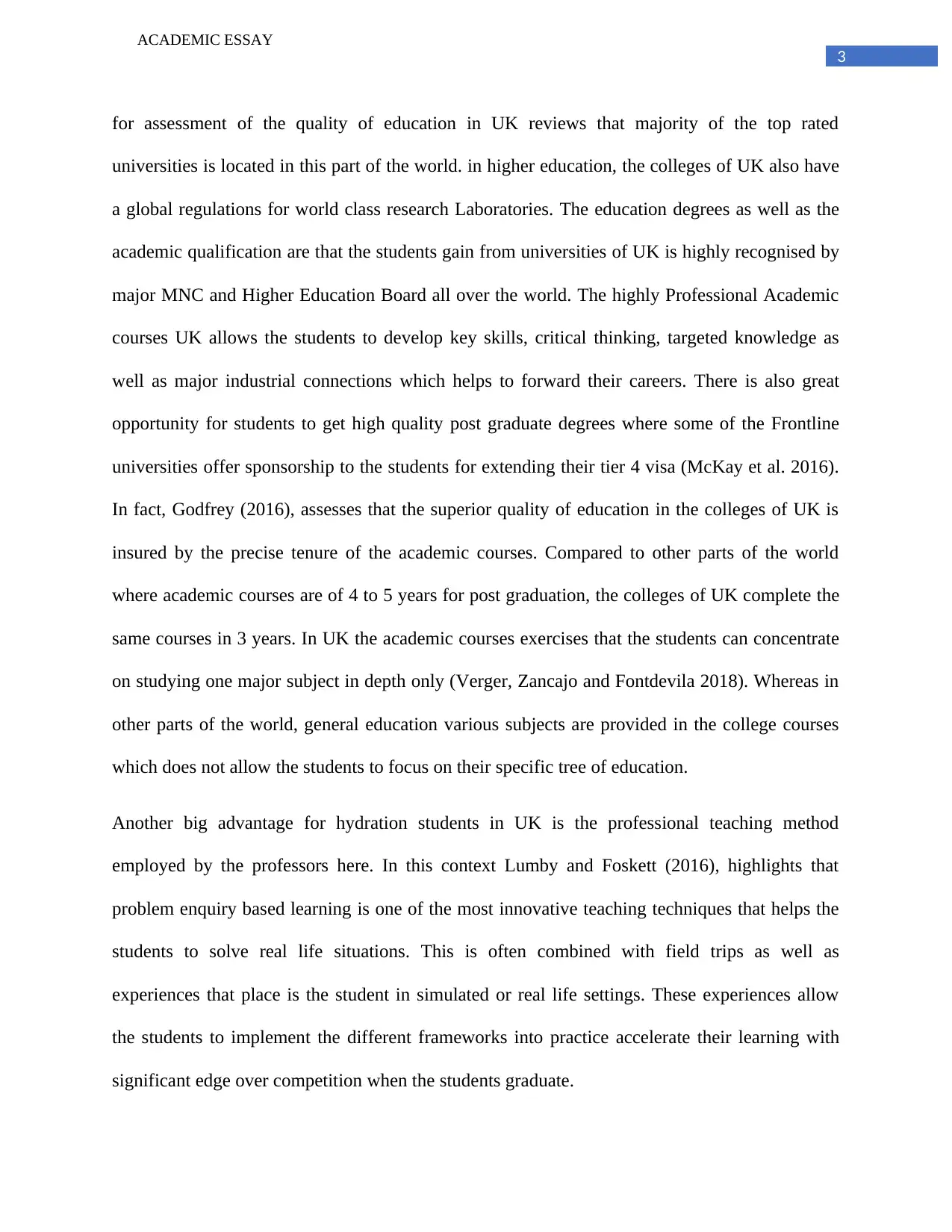
3
ACADEMIC ESSAY
for assessment of the quality of education in UK reviews that majority of the top rated
universities is located in this part of the world. in higher education, the colleges of UK also have
a global regulations for world class research Laboratories. The education degrees as well as the
academic qualification are that the students gain from universities of UK is highly recognised by
major MNC and Higher Education Board all over the world. The highly Professional Academic
courses UK allows the students to develop key skills, critical thinking, targeted knowledge as
well as major industrial connections which helps to forward their careers. There is also great
opportunity for students to get high quality post graduate degrees where some of the Frontline
universities offer sponsorship to the students for extending their tier 4 visa (McKay et al. 2016).
In fact, Godfrey (2016), assesses that the superior quality of education in the colleges of UK is
insured by the precise tenure of the academic courses. Compared to other parts of the world
where academic courses are of 4 to 5 years for post graduation, the colleges of UK complete the
same courses in 3 years. In UK the academic courses exercises that the students can concentrate
on studying one major subject in depth only (Verger, Zancajo and Fontdevila 2018). Whereas in
other parts of the world, general education various subjects are provided in the college courses
which does not allow the students to focus on their specific tree of education.
Another big advantage for hydration students in UK is the professional teaching method
employed by the professors here. In this context Lumby and Foskett (2016), highlights that
problem enquiry based learning is one of the most innovative teaching techniques that helps the
students to solve real life situations. This is often combined with field trips as well as
experiences that place is the student in simulated or real life settings. These experiences allow
the students to implement the different frameworks into practice accelerate their learning with
significant edge over competition when the students graduate.
ACADEMIC ESSAY
for assessment of the quality of education in UK reviews that majority of the top rated
universities is located in this part of the world. in higher education, the colleges of UK also have
a global regulations for world class research Laboratories. The education degrees as well as the
academic qualification are that the students gain from universities of UK is highly recognised by
major MNC and Higher Education Board all over the world. The highly Professional Academic
courses UK allows the students to develop key skills, critical thinking, targeted knowledge as
well as major industrial connections which helps to forward their careers. There is also great
opportunity for students to get high quality post graduate degrees where some of the Frontline
universities offer sponsorship to the students for extending their tier 4 visa (McKay et al. 2016).
In fact, Godfrey (2016), assesses that the superior quality of education in the colleges of UK is
insured by the precise tenure of the academic courses. Compared to other parts of the world
where academic courses are of 4 to 5 years for post graduation, the colleges of UK complete the
same courses in 3 years. In UK the academic courses exercises that the students can concentrate
on studying one major subject in depth only (Verger, Zancajo and Fontdevila 2018). Whereas in
other parts of the world, general education various subjects are provided in the college courses
which does not allow the students to focus on their specific tree of education.
Another big advantage for hydration students in UK is the professional teaching method
employed by the professors here. In this context Lumby and Foskett (2016), highlights that
problem enquiry based learning is one of the most innovative teaching techniques that helps the
students to solve real life situations. This is often combined with field trips as well as
experiences that place is the student in simulated or real life settings. These experiences allow
the students to implement the different frameworks into practice accelerate their learning with
significant edge over competition when the students graduate.
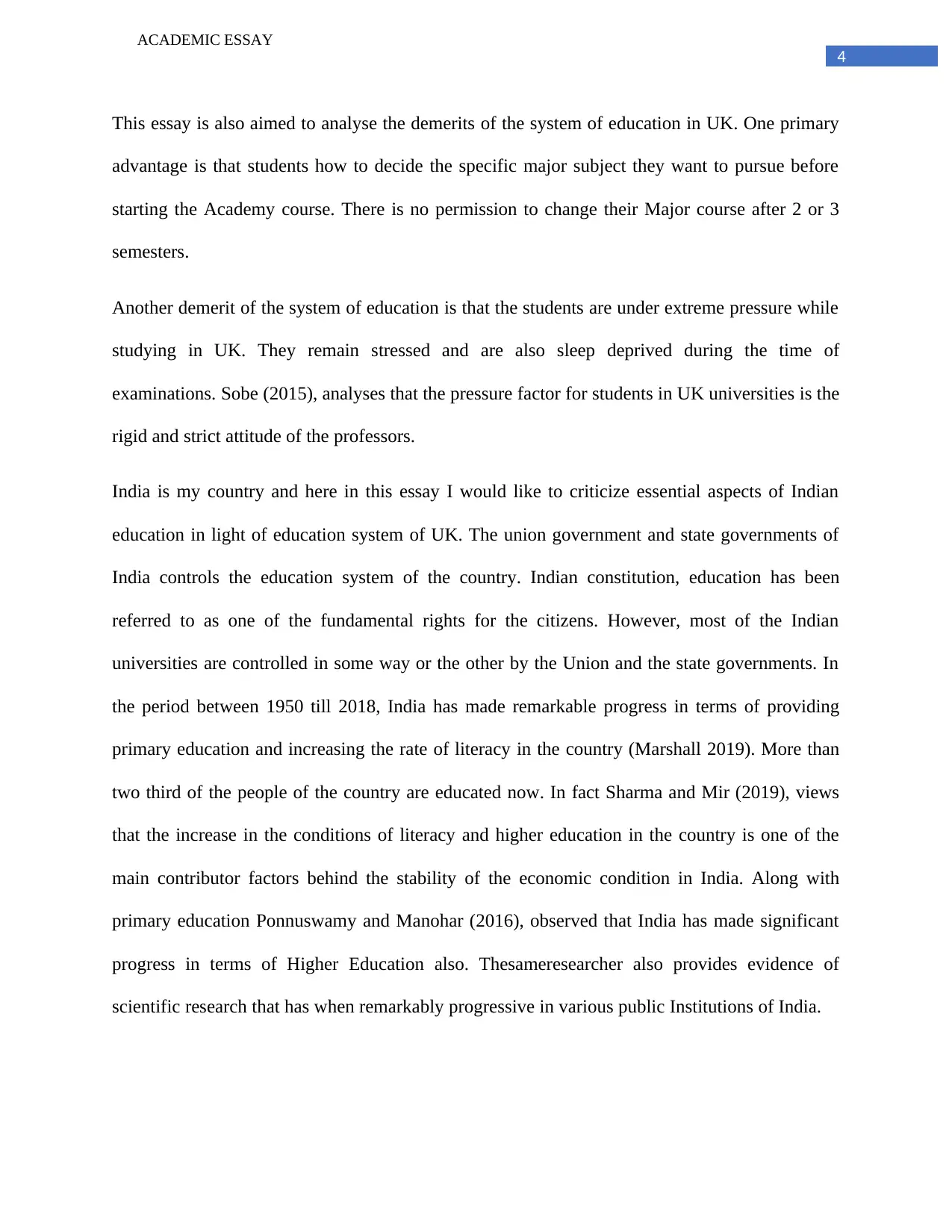
4
ACADEMIC ESSAY
This essay is also aimed to analyse the demerits of the system of education in UK. One primary
advantage is that students how to decide the specific major subject they want to pursue before
starting the Academy course. There is no permission to change their Major course after 2 or 3
semesters.
Another demerit of the system of education is that the students are under extreme pressure while
studying in UK. They remain stressed and are also sleep deprived during the time of
examinations. Sobe (2015), analyses that the pressure factor for students in UK universities is the
rigid and strict attitude of the professors.
India is my country and here in this essay I would like to criticize essential aspects of Indian
education in light of education system of UK. The union government and state governments of
India controls the education system of the country. Indian constitution, education has been
referred to as one of the fundamental rights for the citizens. However, most of the Indian
universities are controlled in some way or the other by the Union and the state governments. In
the period between 1950 till 2018, India has made remarkable progress in terms of providing
primary education and increasing the rate of literacy in the country (Marshall 2019). More than
two third of the people of the country are educated now. In fact Sharma and Mir (2019), views
that the increase in the conditions of literacy and higher education in the country is one of the
main contributor factors behind the stability of the economic condition in India. Along with
primary education Ponnuswamy and Manohar (2016), observed that India has made significant
progress in terms of Higher Education also. Thesameresearcher also provides evidence of
scientific research that has when remarkably progressive in various public Institutions of India.
ACADEMIC ESSAY
This essay is also aimed to analyse the demerits of the system of education in UK. One primary
advantage is that students how to decide the specific major subject they want to pursue before
starting the Academy course. There is no permission to change their Major course after 2 or 3
semesters.
Another demerit of the system of education is that the students are under extreme pressure while
studying in UK. They remain stressed and are also sleep deprived during the time of
examinations. Sobe (2015), analyses that the pressure factor for students in UK universities is the
rigid and strict attitude of the professors.
India is my country and here in this essay I would like to criticize essential aspects of Indian
education in light of education system of UK. The union government and state governments of
India controls the education system of the country. Indian constitution, education has been
referred to as one of the fundamental rights for the citizens. However, most of the Indian
universities are controlled in some way or the other by the Union and the state governments. In
the period between 1950 till 2018, India has made remarkable progress in terms of providing
primary education and increasing the rate of literacy in the country (Marshall 2019). More than
two third of the people of the country are educated now. In fact Sharma and Mir (2019), views
that the increase in the conditions of literacy and higher education in the country is one of the
main contributor factors behind the stability of the economic condition in India. Along with
primary education Ponnuswamy and Manohar (2016), observed that India has made significant
progress in terms of Higher Education also. Thesameresearcher also provides evidence of
scientific research that has when remarkably progressive in various public Institutions of India.
Secure Best Marks with AI Grader
Need help grading? Try our AI Grader for instant feedback on your assignments.
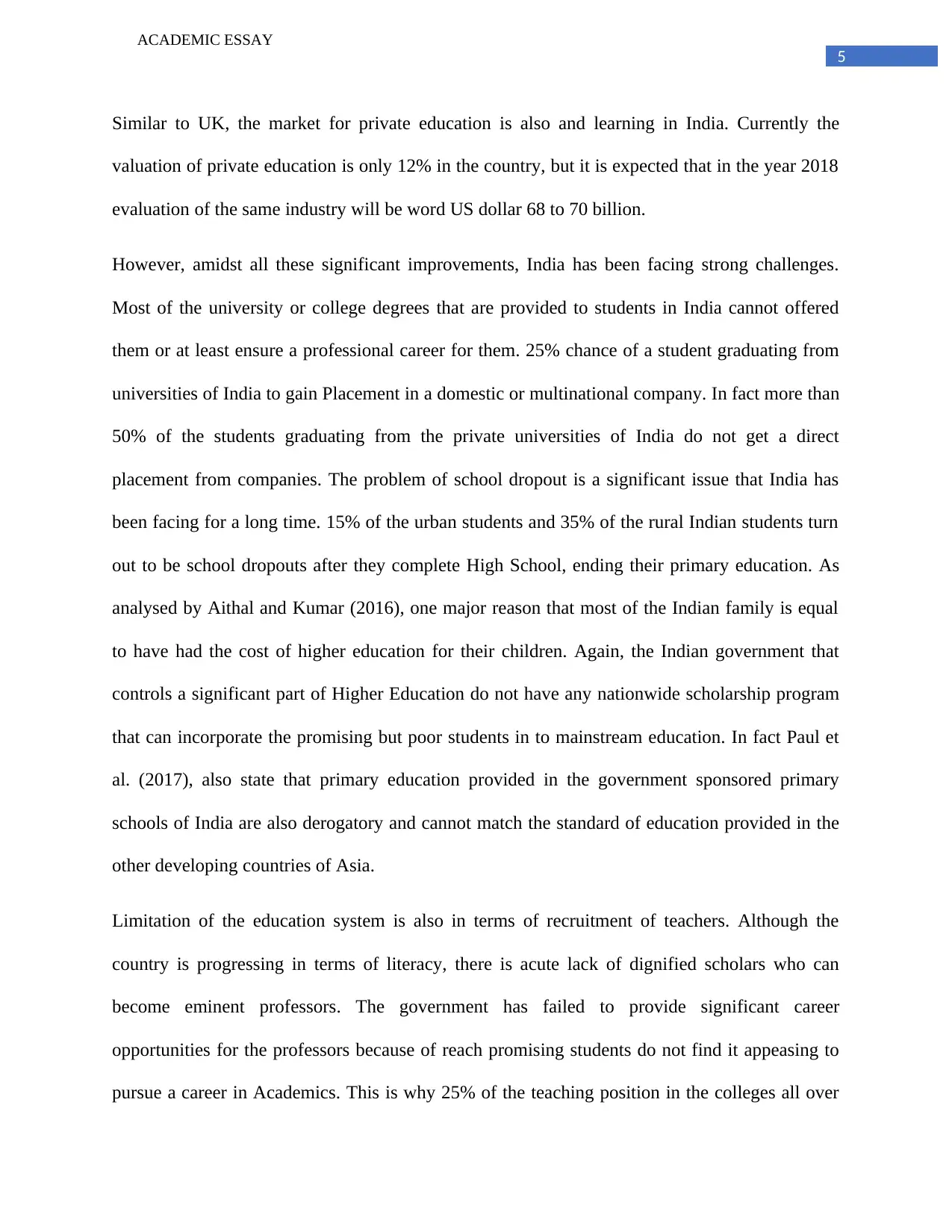
5
ACADEMIC ESSAY
Similar to UK, the market for private education is also and learning in India. Currently the
valuation of private education is only 12% in the country, but it is expected that in the year 2018
evaluation of the same industry will be word US dollar 68 to 70 billion.
However, amidst all these significant improvements, India has been facing strong challenges.
Most of the university or college degrees that are provided to students in India cannot offered
them or at least ensure a professional career for them. 25% chance of a student graduating from
universities of India to gain Placement in a domestic or multinational company. In fact more than
50% of the students graduating from the private universities of India do not get a direct
placement from companies. The problem of school dropout is a significant issue that India has
been facing for a long time. 15% of the urban students and 35% of the rural Indian students turn
out to be school dropouts after they complete High School, ending their primary education. As
analysed by Aithal and Kumar (2016), one major reason that most of the Indian family is equal
to have had the cost of higher education for their children. Again, the Indian government that
controls a significant part of Higher Education do not have any nationwide scholarship program
that can incorporate the promising but poor students in to mainstream education. In fact Paul et
al. (2017), also state that primary education provided in the government sponsored primary
schools of India are also derogatory and cannot match the standard of education provided in the
other developing countries of Asia.
Limitation of the education system is also in terms of recruitment of teachers. Although the
country is progressing in terms of literacy, there is acute lack of dignified scholars who can
become eminent professors. The government has failed to provide significant career
opportunities for the professors because of reach promising students do not find it appeasing to
pursue a career in Academics. This is why 25% of the teaching position in the colleges all over
ACADEMIC ESSAY
Similar to UK, the market for private education is also and learning in India. Currently the
valuation of private education is only 12% in the country, but it is expected that in the year 2018
evaluation of the same industry will be word US dollar 68 to 70 billion.
However, amidst all these significant improvements, India has been facing strong challenges.
Most of the university or college degrees that are provided to students in India cannot offered
them or at least ensure a professional career for them. 25% chance of a student graduating from
universities of India to gain Placement in a domestic or multinational company. In fact more than
50% of the students graduating from the private universities of India do not get a direct
placement from companies. The problem of school dropout is a significant issue that India has
been facing for a long time. 15% of the urban students and 35% of the rural Indian students turn
out to be school dropouts after they complete High School, ending their primary education. As
analysed by Aithal and Kumar (2016), one major reason that most of the Indian family is equal
to have had the cost of higher education for their children. Again, the Indian government that
controls a significant part of Higher Education do not have any nationwide scholarship program
that can incorporate the promising but poor students in to mainstream education. In fact Paul et
al. (2017), also state that primary education provided in the government sponsored primary
schools of India are also derogatory and cannot match the standard of education provided in the
other developing countries of Asia.
Limitation of the education system is also in terms of recruitment of teachers. Although the
country is progressing in terms of literacy, there is acute lack of dignified scholars who can
become eminent professors. The government has failed to provide significant career
opportunities for the professors because of reach promising students do not find it appeasing to
pursue a career in Academics. This is why 25% of the teaching position in the colleges all over
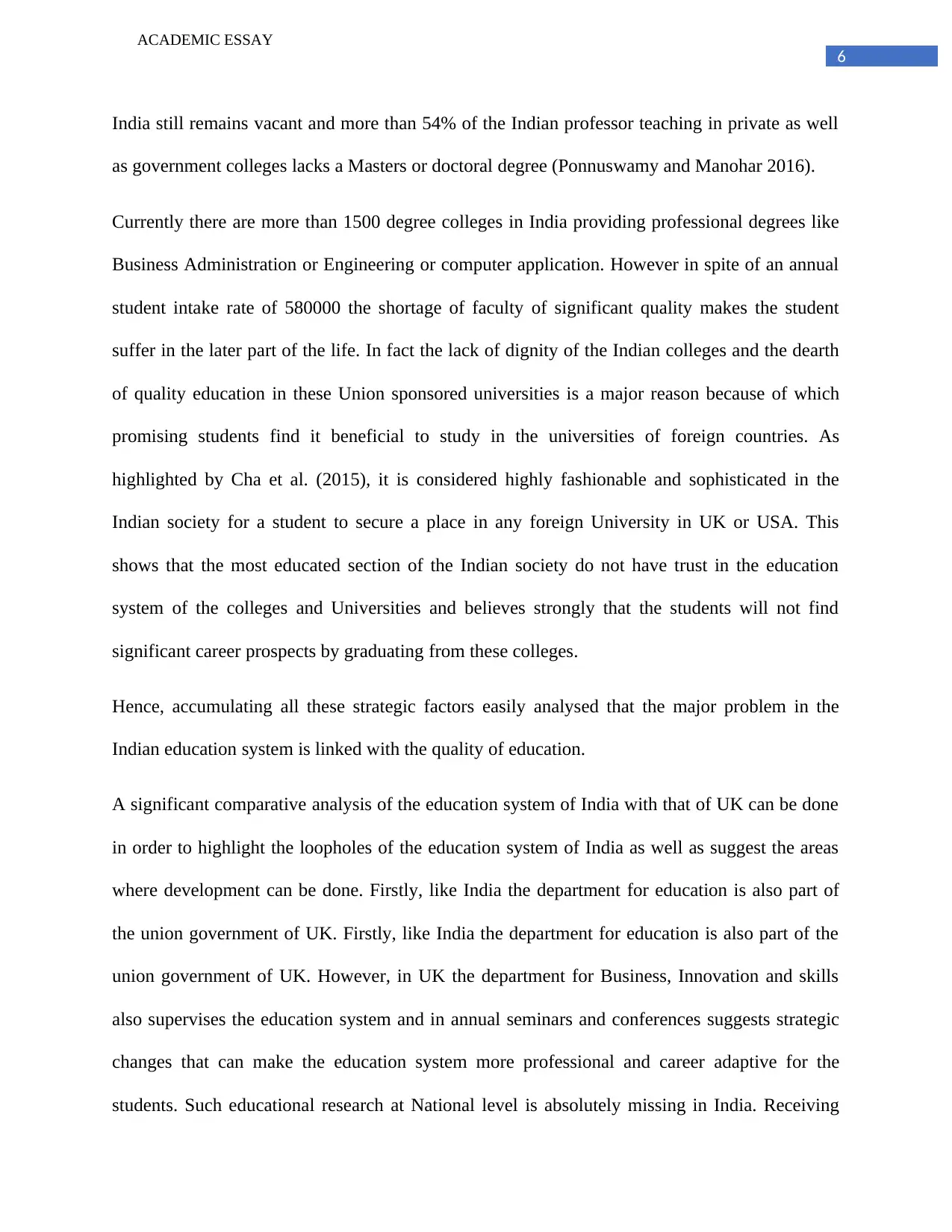
6
ACADEMIC ESSAY
India still remains vacant and more than 54% of the Indian professor teaching in private as well
as government colleges lacks a Masters or doctoral degree (Ponnuswamy and Manohar 2016).
Currently there are more than 1500 degree colleges in India providing professional degrees like
Business Administration or Engineering or computer application. However in spite of an annual
student intake rate of 580000 the shortage of faculty of significant quality makes the student
suffer in the later part of the life. In fact the lack of dignity of the Indian colleges and the dearth
of quality education in these Union sponsored universities is a major reason because of which
promising students find it beneficial to study in the universities of foreign countries. As
highlighted by Cha et al. (2015), it is considered highly fashionable and sophisticated in the
Indian society for a student to secure a place in any foreign University in UK or USA. This
shows that the most educated section of the Indian society do not have trust in the education
system of the colleges and Universities and believes strongly that the students will not find
significant career prospects by graduating from these colleges.
Hence, accumulating all these strategic factors easily analysed that the major problem in the
Indian education system is linked with the quality of education.
A significant comparative analysis of the education system of India with that of UK can be done
in order to highlight the loopholes of the education system of India as well as suggest the areas
where development can be done. Firstly, like India the department for education is also part of
the union government of UK. Firstly, like India the department for education is also part of the
union government of UK. However, in UK the department for Business, Innovation and skills
also supervises the education system and in annual seminars and conferences suggests strategic
changes that can make the education system more professional and career adaptive for the
students. Such educational research at National level is absolutely missing in India. Receiving
ACADEMIC ESSAY
India still remains vacant and more than 54% of the Indian professor teaching in private as well
as government colleges lacks a Masters or doctoral degree (Ponnuswamy and Manohar 2016).
Currently there are more than 1500 degree colleges in India providing professional degrees like
Business Administration or Engineering or computer application. However in spite of an annual
student intake rate of 580000 the shortage of faculty of significant quality makes the student
suffer in the later part of the life. In fact the lack of dignity of the Indian colleges and the dearth
of quality education in these Union sponsored universities is a major reason because of which
promising students find it beneficial to study in the universities of foreign countries. As
highlighted by Cha et al. (2015), it is considered highly fashionable and sophisticated in the
Indian society for a student to secure a place in any foreign University in UK or USA. This
shows that the most educated section of the Indian society do not have trust in the education
system of the colleges and Universities and believes strongly that the students will not find
significant career prospects by graduating from these colleges.
Hence, accumulating all these strategic factors easily analysed that the major problem in the
Indian education system is linked with the quality of education.
A significant comparative analysis of the education system of India with that of UK can be done
in order to highlight the loopholes of the education system of India as well as suggest the areas
where development can be done. Firstly, like India the department for education is also part of
the union government of UK. Firstly, like India the department for education is also part of the
union government of UK. However, in UK the department for Business, Innovation and skills
also supervises the education system and in annual seminars and conferences suggests strategic
changes that can make the education system more professional and career adaptive for the
students. Such educational research at National level is absolutely missing in India. Receiving
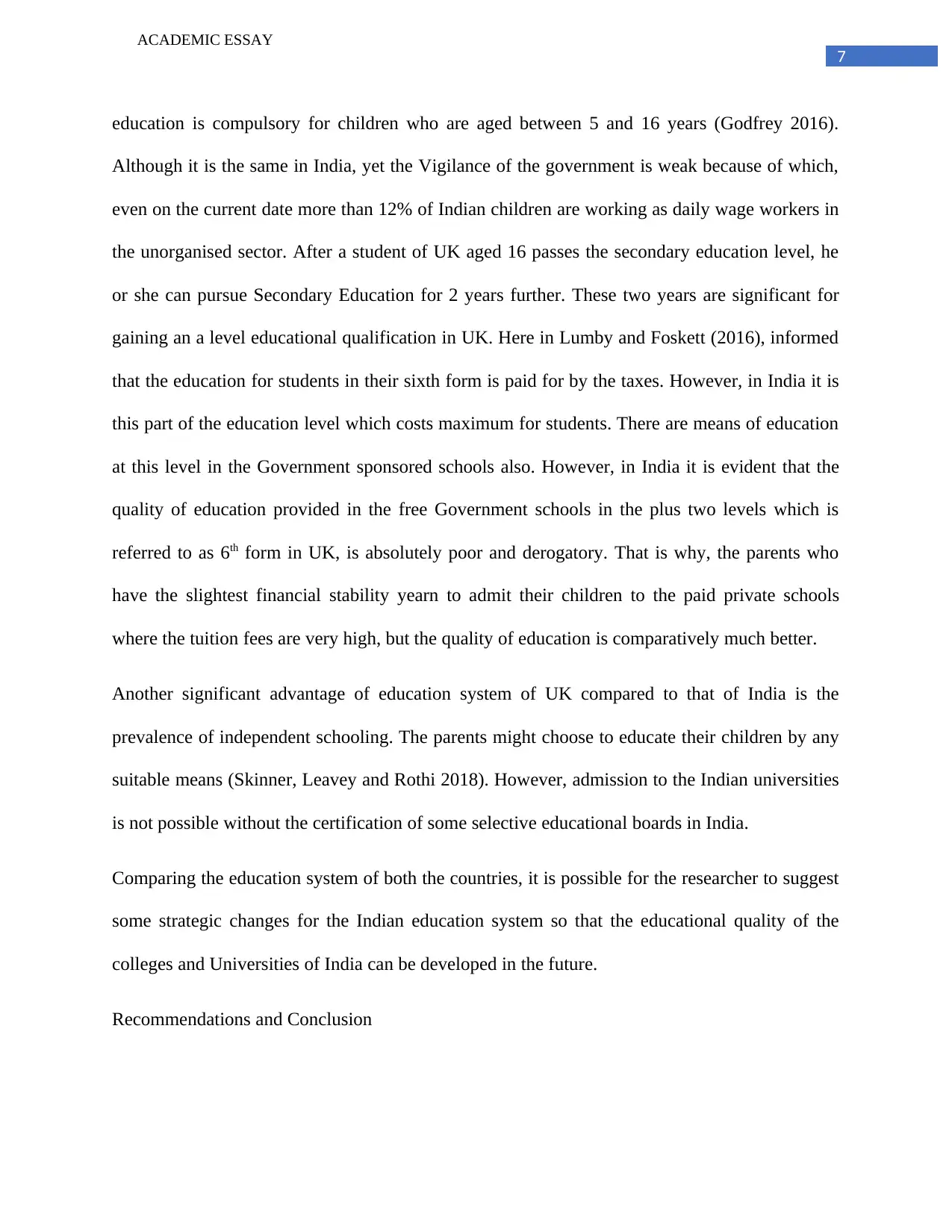
7
ACADEMIC ESSAY
education is compulsory for children who are aged between 5 and 16 years (Godfrey 2016).
Although it is the same in India, yet the Vigilance of the government is weak because of which,
even on the current date more than 12% of Indian children are working as daily wage workers in
the unorganised sector. After a student of UK aged 16 passes the secondary education level, he
or she can pursue Secondary Education for 2 years further. These two years are significant for
gaining an a level educational qualification in UK. Here in Lumby and Foskett (2016), informed
that the education for students in their sixth form is paid for by the taxes. However, in India it is
this part of the education level which costs maximum for students. There are means of education
at this level in the Government sponsored schools also. However, in India it is evident that the
quality of education provided in the free Government schools in the plus two levels which is
referred to as 6th form in UK, is absolutely poor and derogatory. That is why, the parents who
have the slightest financial stability yearn to admit their children to the paid private schools
where the tuition fees are very high, but the quality of education is comparatively much better.
Another significant advantage of education system of UK compared to that of India is the
prevalence of independent schooling. The parents might choose to educate their children by any
suitable means (Skinner, Leavey and Rothi 2018). However, admission to the Indian universities
is not possible without the certification of some selective educational boards in India.
Comparing the education system of both the countries, it is possible for the researcher to suggest
some strategic changes for the Indian education system so that the educational quality of the
colleges and Universities of India can be developed in the future.
Recommendations and Conclusion
ACADEMIC ESSAY
education is compulsory for children who are aged between 5 and 16 years (Godfrey 2016).
Although it is the same in India, yet the Vigilance of the government is weak because of which,
even on the current date more than 12% of Indian children are working as daily wage workers in
the unorganised sector. After a student of UK aged 16 passes the secondary education level, he
or she can pursue Secondary Education for 2 years further. These two years are significant for
gaining an a level educational qualification in UK. Here in Lumby and Foskett (2016), informed
that the education for students in their sixth form is paid for by the taxes. However, in India it is
this part of the education level which costs maximum for students. There are means of education
at this level in the Government sponsored schools also. However, in India it is evident that the
quality of education provided in the free Government schools in the plus two levels which is
referred to as 6th form in UK, is absolutely poor and derogatory. That is why, the parents who
have the slightest financial stability yearn to admit their children to the paid private schools
where the tuition fees are very high, but the quality of education is comparatively much better.
Another significant advantage of education system of UK compared to that of India is the
prevalence of independent schooling. The parents might choose to educate their children by any
suitable means (Skinner, Leavey and Rothi 2018). However, admission to the Indian universities
is not possible without the certification of some selective educational boards in India.
Comparing the education system of both the countries, it is possible for the researcher to suggest
some strategic changes for the Indian education system so that the educational quality of the
colleges and Universities of India can be developed in the future.
Recommendations and Conclusion
Paraphrase This Document
Need a fresh take? Get an instant paraphrase of this document with our AI Paraphraser

8
ACADEMIC ESSAY
Firstly, the problem of illiteracy should be eradicated. It is essential that all the Frontline private
and public schools of India should have a significant quota for inclusion of poor but promising
students aged less than 8 years. These students are supposed to receive government subsidy
irrespective of any reservation quota. Alarmingly, only 7% of the school going population can
finally manage to get education degree in India. Strong government intervention is needed in this
case. The government needs to strictly register and monitor the individual students who pass
primary or secondary stages of education. In case, if the government observed a significant
dropout rate of students in any particular area or state, they should promptly investigate the
cause.
Another important and threatening factor is the poor quality of education in the Government
sponsored schools and colleges. There is no strict invigilation of the education provided in these
educational institutions and many governing bodies take advantage of this fact. This is why it is
needed by the government of India to invest for the development of a strict invigilation
committee for all the private as well as Government sponsored public schools and colleges.
There should be awards and rewards for the best schools and colleges irrespective of the fact that
it is a private or government sponsored Institution.
Again, it is highly recommendable that the government should take strict steps in directing a fees
structure for the private schools as well as private colleges. There should be a legal regulation
that will be preventing the private schools and colleges to charge higher tuition fees than that.
This will encourage many more families to send their children to private schools and colleges.
In the end, it can be recommended that the payment structure for the Teachers as well as
professors of colleges should be revised. As highlighted by the Maslow's hierarchy of needs,
monetary and personal fulfilment are major motivating factors behind employment. In case if the
ACADEMIC ESSAY
Firstly, the problem of illiteracy should be eradicated. It is essential that all the Frontline private
and public schools of India should have a significant quota for inclusion of poor but promising
students aged less than 8 years. These students are supposed to receive government subsidy
irrespective of any reservation quota. Alarmingly, only 7% of the school going population can
finally manage to get education degree in India. Strong government intervention is needed in this
case. The government needs to strictly register and monitor the individual students who pass
primary or secondary stages of education. In case, if the government observed a significant
dropout rate of students in any particular area or state, they should promptly investigate the
cause.
Another important and threatening factor is the poor quality of education in the Government
sponsored schools and colleges. There is no strict invigilation of the education provided in these
educational institutions and many governing bodies take advantage of this fact. This is why it is
needed by the government of India to invest for the development of a strict invigilation
committee for all the private as well as Government sponsored public schools and colleges.
There should be awards and rewards for the best schools and colleges irrespective of the fact that
it is a private or government sponsored Institution.
Again, it is highly recommendable that the government should take strict steps in directing a fees
structure for the private schools as well as private colleges. There should be a legal regulation
that will be preventing the private schools and colleges to charge higher tuition fees than that.
This will encourage many more families to send their children to private schools and colleges.
In the end, it can be recommended that the payment structure for the Teachers as well as
professors of colleges should be revised. As highlighted by the Maslow's hierarchy of needs,
monetary and personal fulfilment are major motivating factors behind employment. In case if the
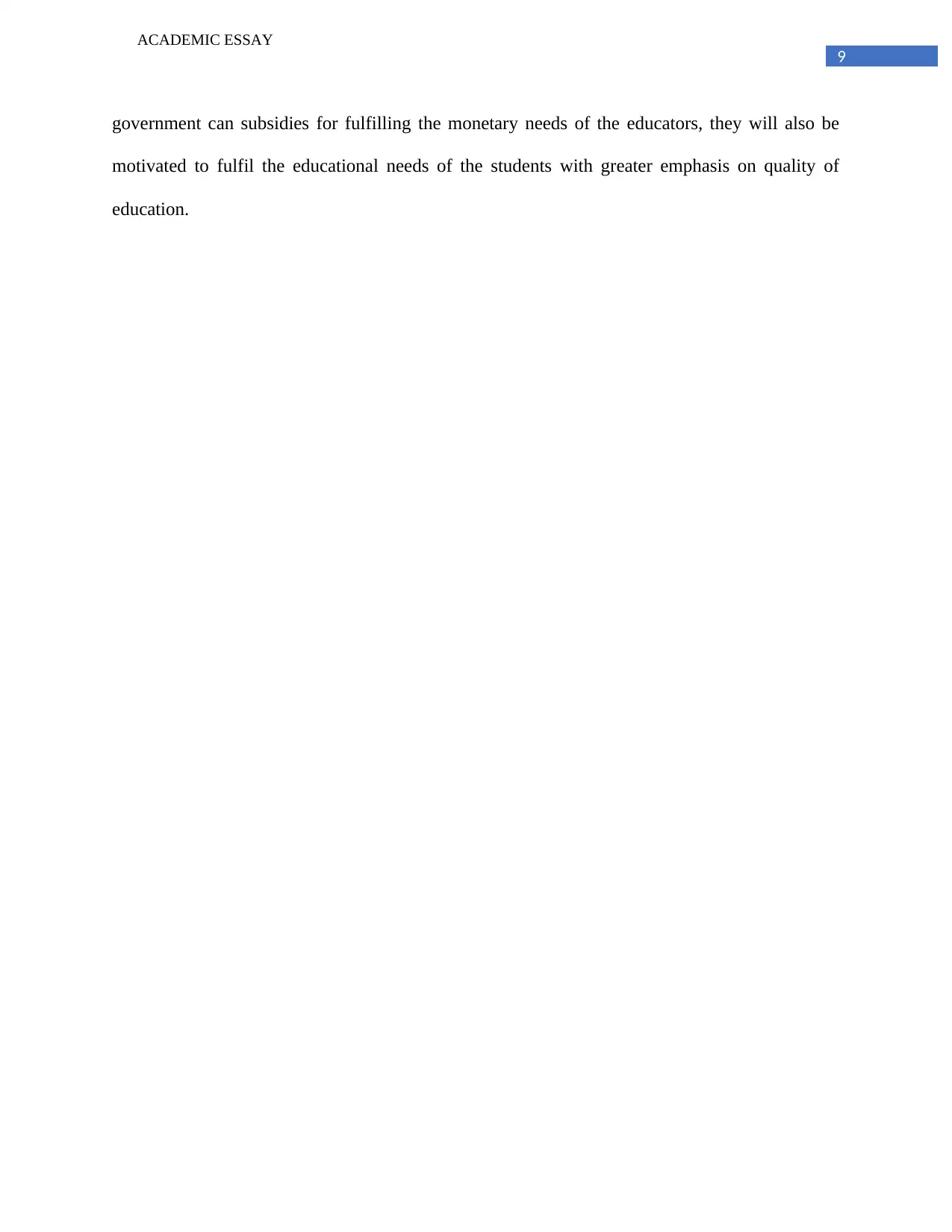
9
ACADEMIC ESSAY
government can subsidies for fulfilling the monetary needs of the educators, they will also be
motivated to fulfil the educational needs of the students with greater emphasis on quality of
education.
ACADEMIC ESSAY
government can subsidies for fulfilling the monetary needs of the educators, they will also be
motivated to fulfil the educational needs of the students with greater emphasis on quality of
education.

10
ACADEMIC ESSAY
Reference List and Bibliography
Aithal, P.S. and Kumar, P.M., 2016. Opportunities and challenges for private universities in
India. International Journal of Management, IT and Engineering, 6(1), pp.88-113.\
Chan, D.K.C., Yang, S.X., Hamamura, T., Sultan, S., Xing, S., Chatzisarantis, N.L. and Hagger,
M.S., 2015. In-lecture learning motivation predicts students’ motivation, intention, and
behaviour for after-lecture learning: Examining the trans-contextual model across universities
from UK, China, and Pakistan. Motivation and Emotion, 39(6), pp.908-925.
Godfrey, D., 2016. Leadership of schools as research-led organisations in the English
educational environment: Cultivating a research-engaged school culture. Educational
Management Administration & Leadership, 44(2), pp.301-321.
Johnston, D.W., Lordan, G., Shields, M.A. and Suziedelyte, A., 2015. Education and health
knowledge: evidence from UK compulsory schooling reform. Social Science & Medicine, 127,
pp.92-100.
Levin, H., 2018. Privatizing Education: Can The School Marketplace Deliver Freedom Of
Choice, Efficiency, Equity, And Social Cohesion?. Routledge.
Lumby, J. and Foskett, N., 2016. Internationalization and culture in higher education.
Educational Management Administration & Leadership, 44(1), pp.95-111.
Marginson, S., 2016. Global stratification in higher education. In Higher education, stratification,
and workforce development (pp. 13-34). Springer, Cham.
Marshall, J., 2019. Introduction to comparative and international education. SAGE Publications
Limited.
ACADEMIC ESSAY
Reference List and Bibliography
Aithal, P.S. and Kumar, P.M., 2016. Opportunities and challenges for private universities in
India. International Journal of Management, IT and Engineering, 6(1), pp.88-113.\
Chan, D.K.C., Yang, S.X., Hamamura, T., Sultan, S., Xing, S., Chatzisarantis, N.L. and Hagger,
M.S., 2015. In-lecture learning motivation predicts students’ motivation, intention, and
behaviour for after-lecture learning: Examining the trans-contextual model across universities
from UK, China, and Pakistan. Motivation and Emotion, 39(6), pp.908-925.
Godfrey, D., 2016. Leadership of schools as research-led organisations in the English
educational environment: Cultivating a research-engaged school culture. Educational
Management Administration & Leadership, 44(2), pp.301-321.
Johnston, D.W., Lordan, G., Shields, M.A. and Suziedelyte, A., 2015. Education and health
knowledge: evidence from UK compulsory schooling reform. Social Science & Medicine, 127,
pp.92-100.
Levin, H., 2018. Privatizing Education: Can The School Marketplace Deliver Freedom Of
Choice, Efficiency, Equity, And Social Cohesion?. Routledge.
Lumby, J. and Foskett, N., 2016. Internationalization and culture in higher education.
Educational Management Administration & Leadership, 44(1), pp.95-111.
Marginson, S., 2016. Global stratification in higher education. In Higher education, stratification,
and workforce development (pp. 13-34). Springer, Cham.
Marshall, J., 2019. Introduction to comparative and international education. SAGE Publications
Limited.
Secure Best Marks with AI Grader
Need help grading? Try our AI Grader for instant feedback on your assignments.
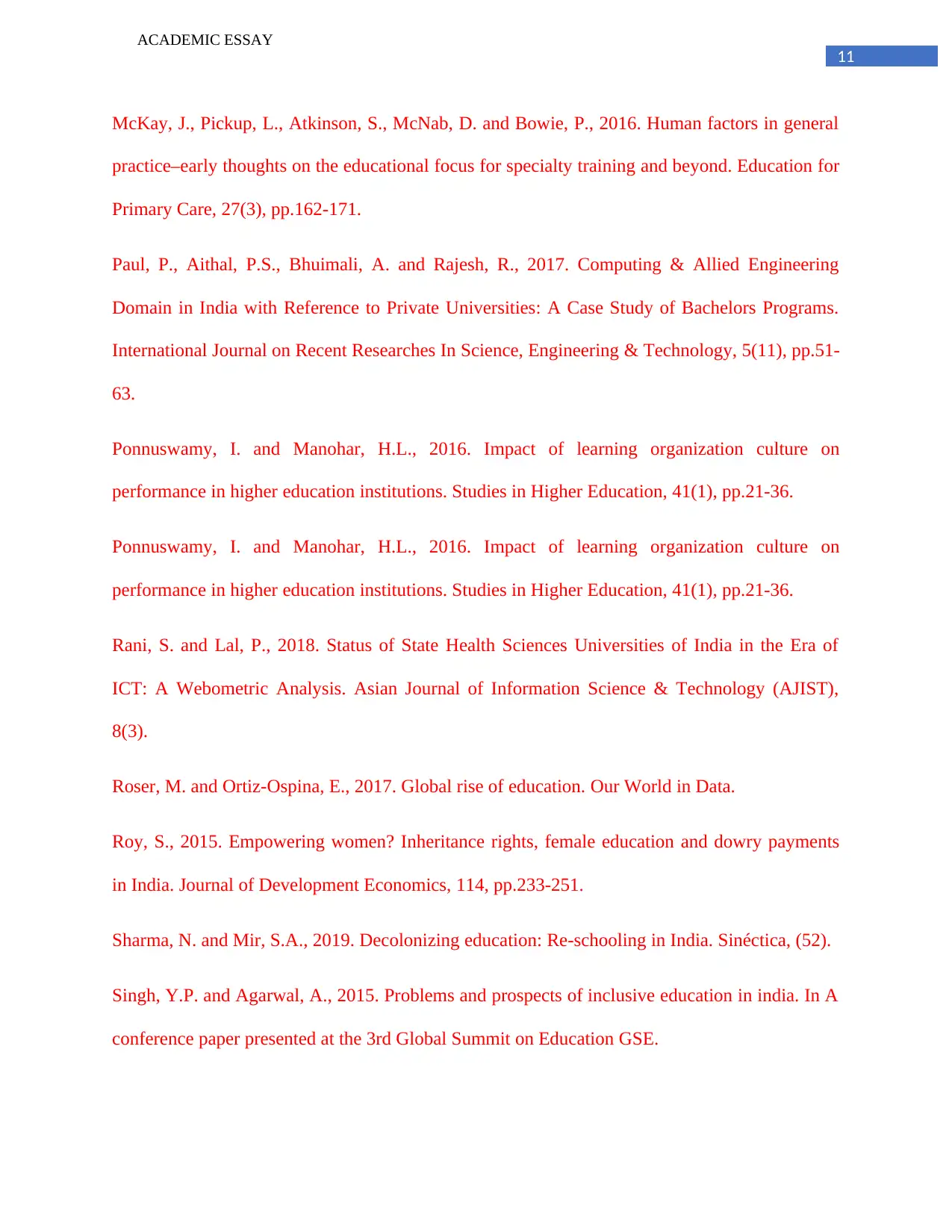
11
ACADEMIC ESSAY
McKay, J., Pickup, L., Atkinson, S., McNab, D. and Bowie, P., 2016. Human factors in general
practice–early thoughts on the educational focus for specialty training and beyond. Education for
Primary Care, 27(3), pp.162-171.
Paul, P., Aithal, P.S., Bhuimali, A. and Rajesh, R., 2017. Computing & Allied Engineering
Domain in India with Reference to Private Universities: A Case Study of Bachelors Programs.
International Journal on Recent Researches In Science, Engineering & Technology, 5(11), pp.51-
63.
Ponnuswamy, I. and Manohar, H.L., 2016. Impact of learning organization culture on
performance in higher education institutions. Studies in Higher Education, 41(1), pp.21-36.
Ponnuswamy, I. and Manohar, H.L., 2016. Impact of learning organization culture on
performance in higher education institutions. Studies in Higher Education, 41(1), pp.21-36.
Rani, S. and Lal, P., 2018. Status of State Health Sciences Universities of India in the Era of
ICT: A Webometric Analysis. Asian Journal of Information Science & Technology (AJIST),
8(3).
Roser, M. and Ortiz-Ospina, E., 2017. Global rise of education. Our World in Data.
Roy, S., 2015. Empowering women? Inheritance rights, female education and dowry payments
in India. Journal of Development Economics, 114, pp.233-251.
Sharma, N. and Mir, S.A., 2019. Decolonizing education: Re-schooling in India. Sinéctica, (52).
Singh, Y.P. and Agarwal, A., 2015. Problems and prospects of inclusive education in india. In A
conference paper presented at the 3rd Global Summit on Education GSE.
ACADEMIC ESSAY
McKay, J., Pickup, L., Atkinson, S., McNab, D. and Bowie, P., 2016. Human factors in general
practice–early thoughts on the educational focus for specialty training and beyond. Education for
Primary Care, 27(3), pp.162-171.
Paul, P., Aithal, P.S., Bhuimali, A. and Rajesh, R., 2017. Computing & Allied Engineering
Domain in India with Reference to Private Universities: A Case Study of Bachelors Programs.
International Journal on Recent Researches In Science, Engineering & Technology, 5(11), pp.51-
63.
Ponnuswamy, I. and Manohar, H.L., 2016. Impact of learning organization culture on
performance in higher education institutions. Studies in Higher Education, 41(1), pp.21-36.
Ponnuswamy, I. and Manohar, H.L., 2016. Impact of learning organization culture on
performance in higher education institutions. Studies in Higher Education, 41(1), pp.21-36.
Rani, S. and Lal, P., 2018. Status of State Health Sciences Universities of India in the Era of
ICT: A Webometric Analysis. Asian Journal of Information Science & Technology (AJIST),
8(3).
Roser, M. and Ortiz-Ospina, E., 2017. Global rise of education. Our World in Data.
Roy, S., 2015. Empowering women? Inheritance rights, female education and dowry payments
in India. Journal of Development Economics, 114, pp.233-251.
Sharma, N. and Mir, S.A., 2019. Decolonizing education: Re-schooling in India. Sinéctica, (52).
Singh, Y.P. and Agarwal, A., 2015. Problems and prospects of inclusive education in india. In A
conference paper presented at the 3rd Global Summit on Education GSE.
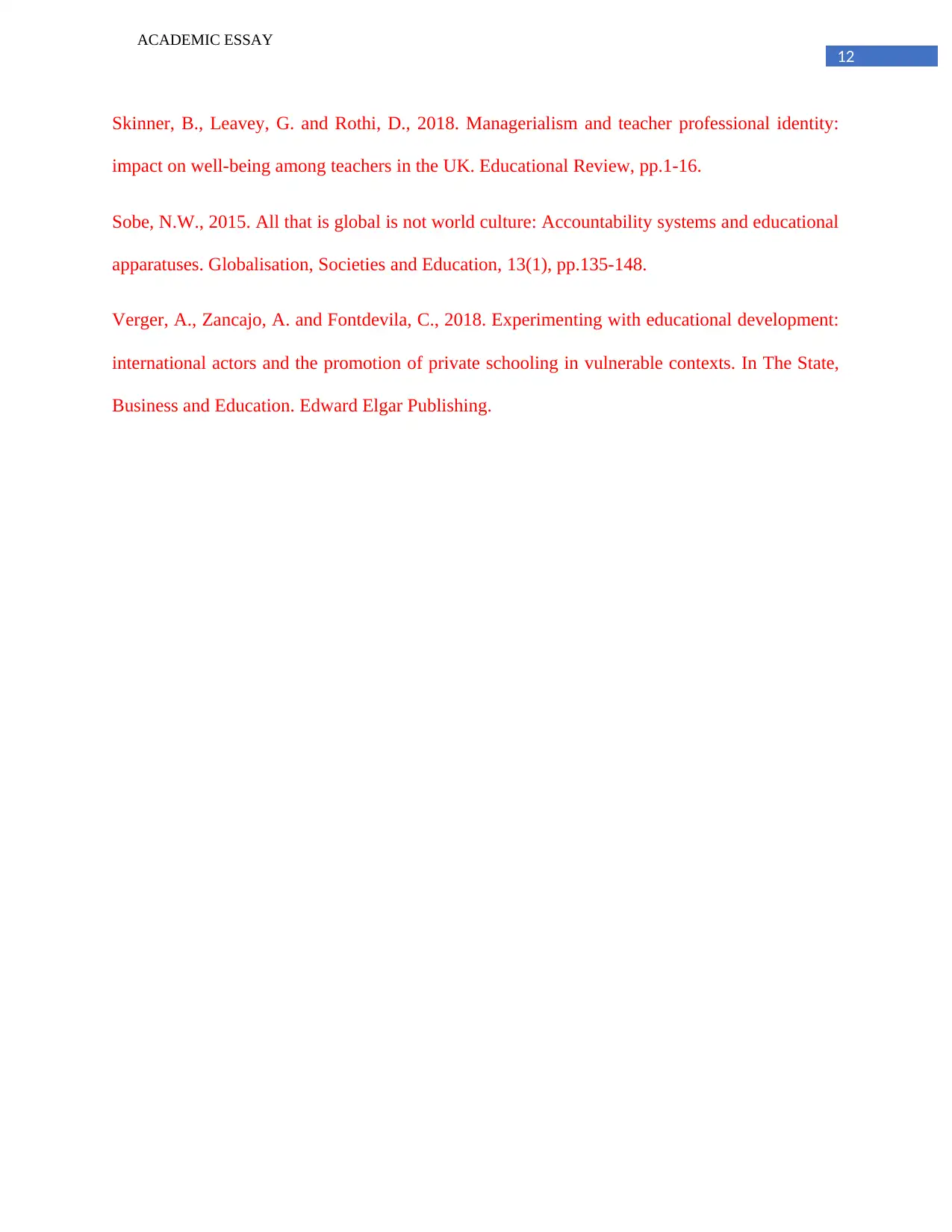
12
ACADEMIC ESSAY
Skinner, B., Leavey, G. and Rothi, D., 2018. Managerialism and teacher professional identity:
impact on well-being among teachers in the UK. Educational Review, pp.1-16.
Sobe, N.W., 2015. All that is global is not world culture: Accountability systems and educational
apparatuses. Globalisation, Societies and Education, 13(1), pp.135-148.
Verger, A., Zancajo, A. and Fontdevila, C., 2018. Experimenting with educational development:
international actors and the promotion of private schooling in vulnerable contexts. In The State,
Business and Education. Edward Elgar Publishing.
ACADEMIC ESSAY
Skinner, B., Leavey, G. and Rothi, D., 2018. Managerialism and teacher professional identity:
impact on well-being among teachers in the UK. Educational Review, pp.1-16.
Sobe, N.W., 2015. All that is global is not world culture: Accountability systems and educational
apparatuses. Globalisation, Societies and Education, 13(1), pp.135-148.
Verger, A., Zancajo, A. and Fontdevila, C., 2018. Experimenting with educational development:
international actors and the promotion of private schooling in vulnerable contexts. In The State,
Business and Education. Edward Elgar Publishing.
1 out of 12
![[object Object]](/_next/static/media/star-bottom.7253800d.svg)





